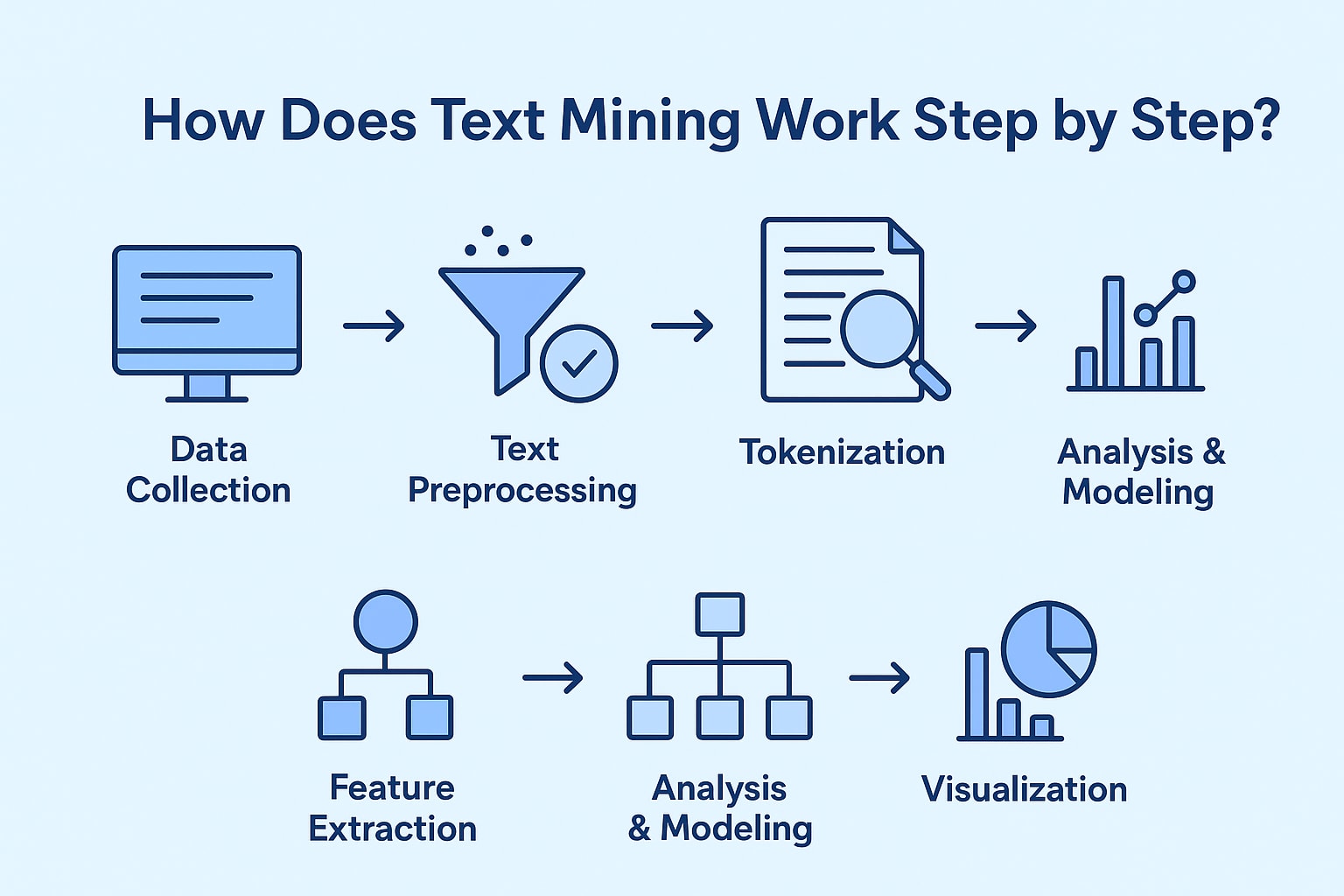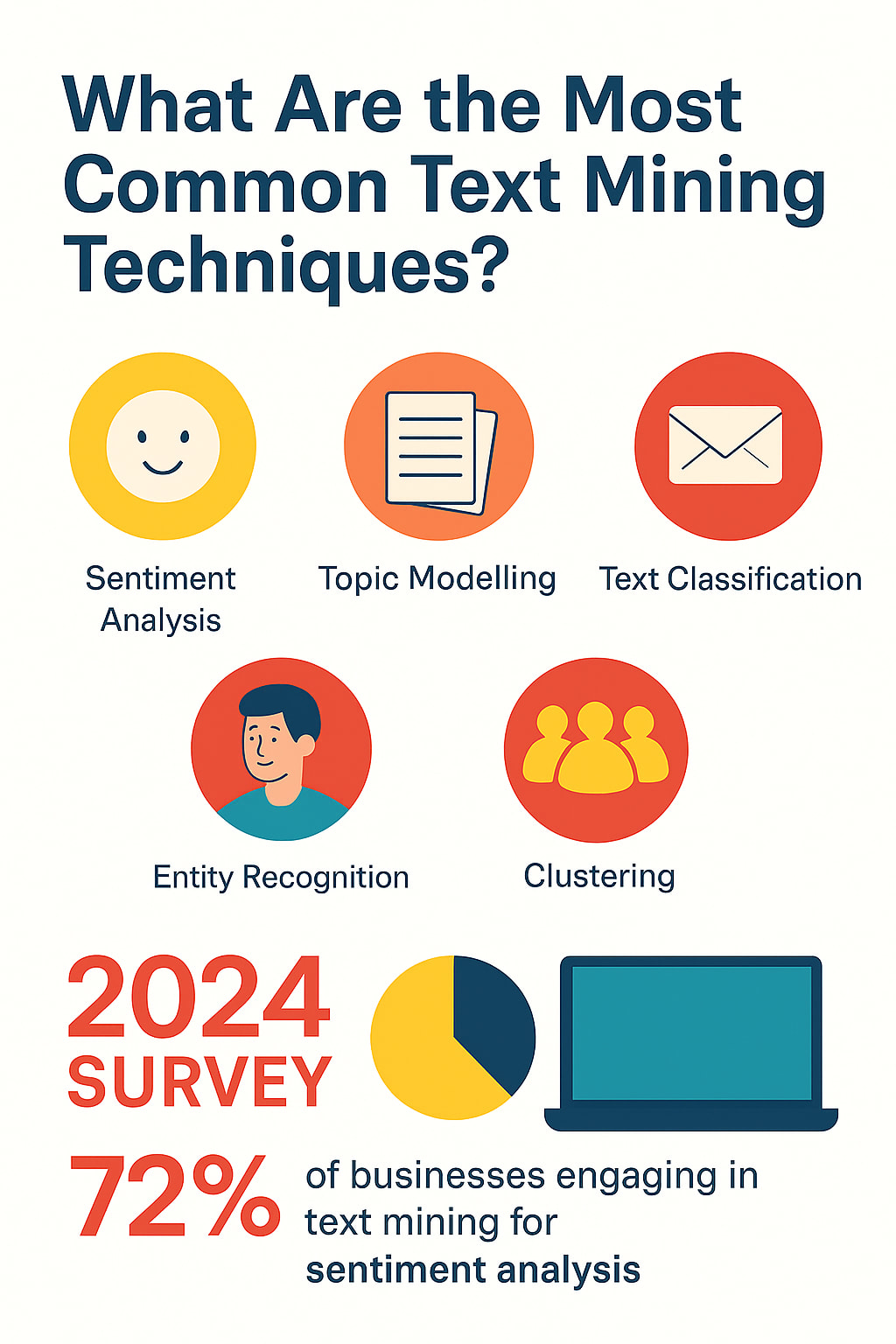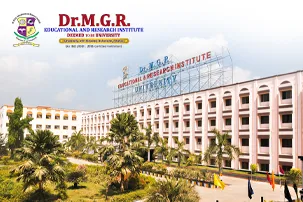Text Mining Made Easy: Definitions, Step-by-Step Tutorial (2025)
Table of Contents

Did you know that about 80% of all the data in the world is unstructured text (tweets, reviews, emails, reports, etc.)? Text mining is the process of making sense of this information overload. In this article, we will explore what text mining is, how it works step by step, what techniques are involved, and why having this skill will be crucial to have in 2025.
What is Text Mining and Why is it Important in 2025?
If you’ve ever tried scrolling through millions of tweets, product reviews, or emails, you’ve wondered how in the world companies can sift through that amount of text. Well, that’s where text mining comes in.
Text mining is defined as the act of transforming unstructured text into meaningful information. Rather than having to read through thousands of documents, text mining allows organisations to extract patterns, trends, and insights through algorithmic reading.
Did You Know: According to IDC, 80 – 90% of the world’s data is unstructured, and a large chunk of that data is text. By 2025, global data is expected to reach 181 zettabytes of data, which makes text mining ever more important.
In short, text mining helps companies turn words into wisdom.
How Does Text Mining Work Step by Step?
If you’re thinking, “Okay, but how does text mining actually work?” – let’s explore that. These are the 5 best text mining techniques and their tips on how to use:

1. Method 1: Sentiment Analysis
Sentiment analysis is the process of identifying the sentiment of specific text, whether it is a positive or negative sentiment or neutral sentiment. This is essential in knowing what the customers think and feel.
How it will be done:
- Harvest Text Data: It is a process of collecting text data across different resources such as reviews, social media, and surveys.
- Preprocess Data: Clean the text data by removing unnecessary information and stop words such as punctuation marks, etc.
- Use NLP Tools: Employ the services of natural language processing tools to determine the sentiment of each bit of text.
- Visualise Results: Make visualizations to show the sentiment trends in the overall view.
An example can be the analysis of customer reviews of a product to check the overall sentiment of customers towards the product, which will guide into making decision-making about product improvement.
2. Method 2: Entity Recognition
Entity recognition (ER) refers to the identification and classification of important entities in text, which might include names and dates, geographical areas, and organizations. It applies to the extraction of specific information in large text datasets.
How it will be done:
- Entity Identification: Run NLP machine learning to identify entities.
- Classify Entities: Classify identified entities based on some preset classes.
- Contextualise: By understanding the context under which things are occurring, there will be vital insights that will be drawn.
Example: Defining and picking up names of mentioned products, localization points, and enterprises in the news articles to analyze trends in the market.
- Data Collection – The collection of text from sources like reviews, social media, or reports.
- Text Preprocessing – The process of cleaning up the data (removing stop words, punctuation, etc).
- Tokenization – The process of breaking down text into smaller units (words or phrases).
- Feature Extraction – The process of identifying keywords, entities, or topics.
- Analysis & Modeling – The process of applying algorithms, like classification, clustering, or sentiment analysis.
- Visualization – The process of displaying insights in graphs, visualizations, dashboards, or word clouds.
You can think about it like cooking. Raw ingredients (data) → cleaned and chopped (preprocessing) → recipe steps (algorithms) → delicious dish (insights).
3. Method 3: Topic Modeling
Topic modeling is a method that helps to identify the prevalence of an existing theme or topic within a set of texts. This assists in the comprehension of the major topics that are addressed in big data.
How it will be done:
- Prepare Data: Collect and modify the text data.
- Select an Algorithm: Such algorithms can be used to pick out topics, e.g., Latent Dirichlet Allocation (LDA).
- Analyze Topics: Read the topics that have been generated and the related keywords.
- Label Topics: Label each topic with some meaning using the keywords.
An example would be to analyze customer service transcripts to determine important categories such as billing questions, technical support, and product questions
4. Method 4: Text Classification
Text classification is the process of assigning pre-determined categories of text based on its content. This comes in handy in structuring and classifying texts in large amounts of texts.
The way to go about it is:
- Define Categories: You should figure out what categories of text you want to classify text into.
- Train a Model: Run machine learning algorithms to learn a model on annotated data.
- Text Classification: Use the model trained previously to classify new text data.
Example: Categorizing customer feedback as a product complaint, service praise, and feature request.
5. Clustering
Grouping clusters of related elements: pieces of text. This assists in finding the patterns and similarities in the text databases of large volumes.
The way to go about it is:
- Clean Input Data: Clean up the input text data.
- Setup: Choose a Clustering Algorithm: Some popular algorithms are K-means and Hierarchical clustering, then you can group similar texts.
- Analyze Clusters: Scan the clusters to get a feel about the general themes or patterns that were followed.
Quantifying customer reviews into clusters to see commonly shared issues and themes amongst customers without prior categories.
What is the Difference Between Text Mining and Text Analytics?
Text mining and text analytics are similar but not identical procedures of deriving meaning out of information provided in written form. Text mining entails the use of Natural language processing and machine learning tools to identify patterns, trends, and knowledge within large deposits of unstructured text.
But Text Analytics is concerned with deriving valuable information, sentiments, and context out of text, and it usually applies statistical and linguistic approaches. Whereas text mining focuses more on the discovery of hidden patterns, text analytics focuses more on the derivation of insights that can be used in decision-making. Both are critical in converting unorganized text into usable knowledge, and in that respect, text mining looks at patterns, and text analytics offers a context to interpret those patterns.
| Aspect | Text Mining | Text Analytics |
|---|---|---|
| Definition | The process of extracting structured information and patterns from unstructured text. | The process of interpreting, analyzing, and drawing actionable insights from text data |
| Focus | Discovery – uncovering hidden patterns, keywords, and relationships | Understanding – making sense of patterns to support decision-making |
| Goal | To find information (e.g., topics, entities, clusters). | To interpret and apply information (e.g., trends, insights, predictions). |
| Techniques Used | Preprocessing, tokenization, entity extraction, clustering, and topic modeling. | Sentiment analysis, trend analysis, predictive modeling, business intelligence. |
| Output | Structured data (keywords, topics, entities, patterns). | Actionable insights (customer sentiment, future trends, business decisions) |
| Example Use | Identifying that customers often mention “battery life” in reviews | Analyzing whether “battery life” mentions are mostly positive or negative to improve products. |
What is Text Mining in Data Mining and How Are They Connected?
Have you ever thought about how businesses can process thousands of customer reviews, tweets, emails, etc., in a matter of minutes? Through text mining, which is related to data mining.
What is Text Mining?
Text mining is a little like teaching a computer to “read in between the lines.” It is the process of taking messy, unstructured text (reviews, social media posts, reports, etc.) and organizing it into structured data. To analyze the message or meaning in text, we “clean” it, break it down (tokenize it), and analyze the words provided to discover the latent patterns, keywords, sentiment, and topics in the text.
What is Data Mining?
Data mining is what I like to call a big picture (broader) process. It is digging through any kind of data, whether it is numbers, transactions, logs, or just text, to discover patterns, trends, and predictions. An analogy of this process is like mining for gold; you have tons of raw material and extract nuggets that have some value.
How Do Text and Data Mining Relate to Each Other?
In effect, text mining is a form of data mining, and it is a sub-area of data mining. Data mining works with structured data (sales numbers, website traffic patterns, customer demographics, etc.), while text mining is of use on unstructured text. When combined, they provide a business with an all-encompassing view of what’s going on.
For example:
Data mining – shows what is going on (a 20% sales decline).
Text mining – shows why there is a decline in sales (customers are mentioning in their reviews that the service is poor).
What Are the Most Common Text Mining Techniques?
Text mining isn’t simply one process. Instead, it’s multiple techniques to produce powerful results:
- Sentiment Analysis – The detection of emotions attached to text (positive, negative, neutral).
- Topic Modeling – The grouping of text based on key themes.
- Text Classification – The classification of text into categories (e.g., spam vs. not spam emails).
- Entity Recognition – The detection of names, locations, or organizations in text.
- Clustering – The grouping of similar text without any predetermined categories.

According to a 2024 survey conducted in conjunction with Deloitte, 72% of businesses reported engaging in text mining for sentiment analysis to enhance customer engagement.
What Are the Real-World Applications of Text Mining?
Have you ever noticed how Netflix always seems to have the right show or how companies quickly respond to your complaints on Twitter? That’s text mining!
Text mining isn’t just a flashy tech term; it’s something you see wherever you go in our day-to-day lives. Here are some real-world applications broken down simply:
- Customer Feedback
Businesses will often use text mining to read and scan reviews, surveys, and social media posts. This helps them uncover what customers really like versus when customers are actually upset. Example: An e-commerce brand will easily discover complaints regarding “late delivery.”
- Social Media Sentiment Analysis
Businesses can look at and analyze social media platforms to see how the public perceives their brand, product, and/or event. In essence, it gives businesses an understanding of whether the general sentiment is positive, negative, or neutral.
- Healthcare & Medical Research
Doctors and researchers use text mining to pore through medical records, journals, and patient feedback. Text mining helps in predicting diseases, identifying new drugs, and getting to patient concerns much quicker!
- Fraud Detection & Risk Management
Banks and insurance companies apply text mining to email data (emails, claims, chats) to find fraudulent activity. This prevents fraudulent activity from getting too expensive.
- Market Research & Predicting Trends
Text mining enables companies to sift through news articles, forums, and blogs to identify trends before they happen. For example, if a company could spot the hype surrounding “recyclable packaging” before another company, that company could jump on the chance to bring its sustainable product to market faster than its competitors.
- Chatbots & Virtual Assistants
Text mining is what helps your Alexa, Siri, or customer service chatbot interpret your question and give you an appropriate answer.
Hook takeaway: Text mining is everywhere – helping businesses listen, physicians to research faster, and machines to respond more intelligently. So the next time Netflix recommends to you your next favorite movie, remember it’s not magic – it’s text mining!
What Are the Benefits of Using Text Mining for Businesses?
- It saves time using automated text analysis.
- It improves the customer experience using sentiment analysis.
- It improves decision-making by helping to uncover hidden trends.
- It provides competitive insights using market chatter.
According to McKinsey, companies that leverage advanced text analytics can increase their profitability by 15% or more.
What Are the Challenges and Limitations of Text Mining?
Naturally, there are still issues associated with text mining.
- Data Quality Issues – Unclean or biased data has an impact on results.
- Language Complexity – Sarcasm, culture-based language, and multi-lingual text are difficult to analyze.
- Privacy Concerns – Mining sensitive data on customers brings ethical issues.
- Computational Costs – Text mining at scale requires a lot of compute.
However, improvements in the field of AI are already helping solve some of these constraints every year.
What Are the Best Tools and Software for Text Mining in 2025?
| Tool / Platform | What It Excels At | Best For |
|---|---|---|
| KNIME | Visual workflows, integration, and large data handling | Visual data analysts |
| RapidMiner | Low-code text analytics, real-time modeling | Business analysts & researchers |
| SAS Text Miner | High-performance processing, automated rule generation | Enterprise-grade text mining |
| IBM Watson NLU | Deep language insights, enterprise integration | Large-scale semantic analysis |
| MonkeyLearn | No-code setup, feedback classification | SMEs & operational teams |
| MeaningCloud | Affordable, language-rich analytics | Cost-conscious multilingual teams |
| Brandwatch / Kapiche | Social listening & customer feedback interpretation | Marketing & customer insight teams |
| Luminoso, AYLIEN, WordStat, etc. | Specific niche features across sentiment & research | Domain-focused users |
| spaCy / NLTK / GPT APIs | Custom pipelines, prototyping, summaries | Developers & researchers |
| AWS Comprehend / GCP NLP / Luminance | Scalable enterprise use, document analysis | Cloud-powered enterprise users |
| NetMiner 5 | Text + network analysis, AI-assisted interpretation | Advanced researchers, SNA analysts |
How to Learn Text Mining and Build a Career in It?
If you’re interested in the field of text mining and you’re not sure where to start, don’t worry! You don’t need to be an expert right away. The first step is to gain a solid understanding of Python and Data Analysis, because Python is the most popular programming language for text mining.
This is also where Jaro Education’s free Python for Data Analysis courses can be a great starting point. The beginner courses cover:
– Basics of Python programming (variables, loops, functions)
– Data Analysis with packages like Pandas and NumPy
– Introduction to data cleaning and pre-processing (an essential part of text mining)
– Hands-on practice with real datasets
If you learn these skills, you’ll be able to extract and clean the raw data into a usable format, and that’s the first step in the text mining process!
Conclusion – Why Text Mining Is the Future of Data Analysis
The world is being inundated with data, and much of it is text. Businesses, researchers, and governments have implemented text mining just to keep pace and make decisions more quickly and thoughtfully.
Text mining is not a weekend project, and with AI and machine learning, it is rapidly being advanced from a skill that could be done by a single practitioner to a career-defining capability. Starting in 2025, the ability to find meaning in words will match the value of parsing numbers.
So if you have ever wondered, “Should I learn text mining?” you have your answer!
Frequently Asked Questions
What is text mining?
Text mining is the process of extracting useful information and patterns from unstructured text data such as emails, reviews, or social media posts. It uses techniques like natural language processing (NLP) and machine learning to turn words into meaningful insights.
How does text mining work in data mining?
Text mining in data mining focuses on analyzing unstructured text, while traditional data mining works on structured data like numbers and tables. Together, they give organizations a complete picture by combining both types of data for better decision-making.
What are the common text mining techniques?
The most widely used text mining techniques include:
- Sentiment analysis (detecting emotions)
- Text classification (categorizing documents)
- Topic modeling (finding themes in text)
- Named entity recognition (detecting names, places, brands)
- Clustering (grouping similar text)
What is the difference between text mining and text analytics?
The two terms are often used interchangeably, but they differ slightly:
Text mining is about discovering hidden patterns and extracting knowledge.
Text analytics is about interpreting and visualizing those patterns to support decisions.
Think of text mining as the “discovery phase” and text analytics as the “action phase.”
Why is text mining important today?
Text mining is important because over 80% of business data is unstructured text. Without text mining, organizations miss out on valuable insights hidden in emails, chat messages, reviews, and reports. By 2025, companies using advanced text mining are expected to have 20–30% better decision-making efficiency, according to Gartner.

















